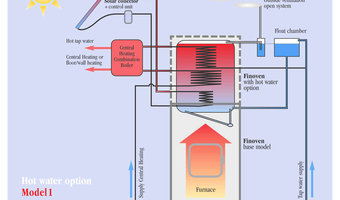In a not-insulated home, the heater will cool down faster than in an insulated home. In other words, experiencing the heated area, the sense of comfort (at 20°C) in part of the building, depends for the most part on the insulation value. The better the insulation, the larger the comfort area.
This first step in exchanging heat is the simplest one, and is particularly comfort-efficient in low-energy homes.
A hot Tigchel heater continuously exchanges heat with its environment on the basis of radiant heat. A floor (under the heater) with floor heating will feel this heat first and most intense. After X hours the heater will heat the floor more than just the floor heating by itself. At this spot the floor heating system receives "new" heat that is evenly absorbed. The floor heating will so intensify the spread of heat throughout the home.
A stucco Finoven can be coiled with floor heating pipes. These water-filled pipes are hidden inside the stucco. Through the direct transfer via the hot stucco to the pipes, the Finoven is evenly 'cooled'. Much of the heat distribution is realised through linking various (groups of) pipes.
Heat exchangers are available to extract more heat. Using a heat exchanger to cool down part of the hot flue gases from the heater will result in higher water temperatures (approx. 90°C). Two models are available for this purpose, as shown above. Model 1 and 2 can be combined with various furnaces.

